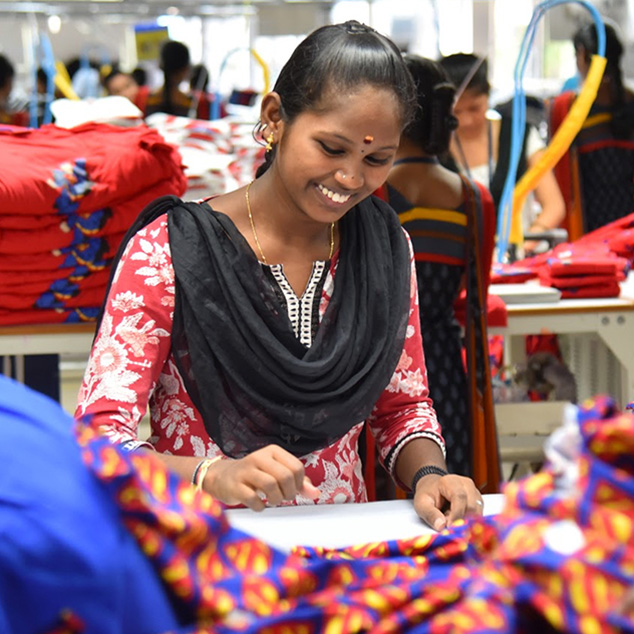
Carbon Footprint
WHAT IS A “CARBON FOOTPRINT”?
Every process and product leaves a footprint on the environment.
Calculating your “carbon footprint” is a way of measuring the greenhouse gas (GHG) emissions of a product, service or organisation. It essentially allows us to assess our potential impact on climate change. OVS made this calculation for the first time in 2018 and has continued in the intervening years to analyse the impact of its business activities on the environment.
THE REFERENCE CONTEXT
In recent years, sustainable development has become central to international debate in the economic, institutional, political and social spheres. This interest essentially boils down to climate change and the negative impact it is having on the world we live in.
Climate change has accelerated since the industrial revolution and is closely linked to greenhouse gas emissions, mainly due to the use of fossil fuels.

The image clearly shows that global emissions have been increasing steadily in recent decades and, most importantly, it demonstrates the need to adopt increasingly strict policies and challenging objectives if we are to prevent irreversible and exponential climate phenomena and events.

The urgency of the current situation was confirmed at the 2022 World Economic Forum (WEF), which identified environmental risks as the most serious threat to society, particularly in terms of the short and long-term climate crisis and loss of biodiversity.
The global fashion industry is one of the most polluting sectors in the world. Research by the European Environment Agency has revealed that the textile industry is the fourth biggest environmental polluter in the world after the food, construction, and transport industries. The clothing and footwear sector is responsible for 10% of all global greenhouse gas emissions.
In October 2018, OVS joined the Italian Programme for Calculating Environmental Footprints, which is a voluntary scheme promoted by the Italian Ministry for the Environment, Land and Sea to help businesses realise just how important it is for them to calculate and reduce the environmental impact of their activities. As part of the project, our 2018 carbon footprint was certified by SGS, in compliance with the requirements of international standard ISO 14064-1.
IMPACT ASSESSMENT RESULTS
In 2020, OVS's carbon footprint for all direct and indirect emissions was 370,866 tonnes CO2eq*.
The direct (5%) and induced (95%) impact of OVS’s activities is compared in the graph below:

* We have reassessed our total emissions compared to the data we published in our 2020 sustainability reports after adjusting our calculation methodology. Data now includes emissions produced by our distribution centre (previously excluded from annual reporting). Our disclosure will be aligned with our 2021 sustainability report.
OVS’s emissions for the last two years:
| Emissions in tCO2eq | 2019 | 2020 |
|---|---|---|
| Scope 1 | 11,780 | 8,779 |
| Scope 2 | 8,009 | 9,862 |
| Total partial | 19,789 | 18,641 |
| Scope 3 | 436,431 | 352,225 |
| Total | 456,220 | 370,866 |
Scope 1 emissions include direct GHG emissions from OVS operations, and in particular, from: stationary combustion for heating facilities (e.g., natural gas, diesel oil), mobile combustion for the company fleet (e.g., LPG, gasoline, diesel oil), and fugitive emissions from our central warehouse, headquarters, and directly managed shops in Italy.
Scope 2 emissions include indirect GHG emissions due to the consumption of purchased electricity and district heating used in OVS operations.
Finally, scope 3 emissions include GHG emissions related to purchased goods and services (raw materials, processing, and packaging), other materials, transport relating to upstream and downstream logistics and distribution, waste disposal, and sold products that have reached the end of their useful life. Emissions relating to raw materials, processing, and inbound logistics have been evaluated using a bottom-up approach, permitting reconciliation at the individual product level.
Scope 3 emissions are categorised according to the GHG Protocol below:
| Category | 2019 (Baseline year) |
2020 (Most recent year) |
|---|---|---|
| 1. Purchased goods and services | 316,182 | 245,925 |
| 2. Capital goods | 29,538 | 24,497 |
| 3. Fuel and energy activities** | 15,408 | 5,259 |
| 4. Upstream transportation and distribution | 29,284 | 33,272 |
| 5. Waste generated in operations** | 5,985 | 8,939 |
| 6. Business travel | 1,200 | NA |
| 7. Employee commuting | 4,500 | 3,300 |
| 8. Upstream leased assets | 2,400 | 2,400 |
| 9. Downstream transportation and distribution** | 2,054 | 1,778 |
| 10. Processing of sold products | NA | NA |
| 11. Use of sold products | NA | NA |
| 12 End-of-life treatment of sold products | 19,679 | 16,267 |
| 13. Downstream leased assets | NA | NA |
| 14. Franchises | 10,200 | 10,588 |
| 15. Investments | NA | NA |
** Emissions category excluded from reduction plan
We have calculated our carbon footprint based on the activities of OVS S.p.A. in Italy as the Company handles more than 90% of all OVS group operations, and includes housebrand clothing.
Reduction plan
Our reduction plan contains a number of specific targets that have been selected based on their level of ambition, i.e., their ability to bring about material improvement – beyond a 'business as usual' approach – and their consistency with OVS's sustainability strategy. In particular, OVS is committed to:
- reduce absolute scope 1 and 2 GHG emissions 46.2% by FY2030 from a FY2019 base year;
- increase annual sourcing of renewable electricity from 91.4% in FY2019 to 100% by FY2030;
- reduce absolute scope 3 GHG emissions from purchased goods and services, and upstream transportation and distribution 46.2% by FY2030 from a FY2019 base year.
The SBTi’s Target Validation Team has classified OVS's scope 1 and 2 target ambition and has determined that it is in line with a 1.5°C trajectory (click here to read the certificate).
Our reduction targets also coincide with our Sustainability Performance Targets (SPT), as defined in the Sustainability-Linked Bond we issued in November 2021 (click here to read more). We are therefore working to strengthen OVS’s objectives and our commitment to the actions under way to achieve them.
OVS’s sustainability strategy contains practical plans and initiatives on how we can reduce our environmental impact and emissions, adopting the following approaches to do so:
- increasing the use of more sustainable materials when manufacturing products – opting for organic and/or recycled solutions – as well as using less impactful manufacturing processes and techniques. We are also replacing existing virgin plastic packaging materials with recycled or renewable materials;
- we will be increasing our use of solar energy systems at our corporate facilities and shops, thus improving our energy efficiency – focusing in particular on lighting and heating systems – and involving non-owned stores in switching to renewable electricity supplies;
- at a supply chain level, we will be collaborating with and helping our suppliers to embrace new low-emissions technologies and renewable energy sources, including through their involvement with the Higg platform;
- at a transport level, we intend to progressively upgrade our company car fleet, choosing vehicles with a lower environmental impact (e.g., hybrid or electric cars) and developing a long-term, inter-seasonal product offering that allows OVS to reduce its need for fast inbound product shipments, thus reducing our reliance on air transport.
Offsetting activities
OVS has purchased CO2 neutralisation certificates to offset the emissions of the products it sells online by supporting a forest conservation project in Brazil. See the certification PDF.
SBTi - Science Based Targets Initiative
SBTi is a partnership between CDP, the UN Global Compact, the World Resources Institute (WRI), and the World Wide Fund for Nature (WWF), which drives ambitious climate action in the private sector by helping companies to set science-based emissions reduction targets.
THE SCIENTIFIC METHODOLOGY USED TO CALCULATE OUR ENVIRONMENTAL FOOTPRINT
We used the following methodologies to perform our analysis:
- ISO 14040 and 14044 (ISO, 2006a, b)
- ISO 14064-1 (ISO, 2018)
- GHG Corporate Standard Protocol
- Apparel and Footwear sector: Science Based Targets Guidance (SBT, 2019)
This methodology is based on the principles of environmental responsibility and transparency in the publication of results.











